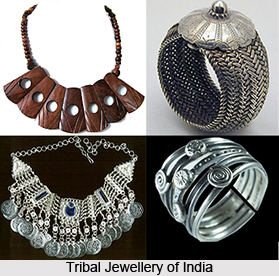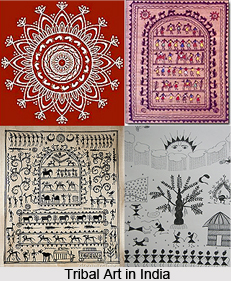 Indian tribal craft is an astounding section in modern Indian times, which slowly has taken in a cosmopolitan appearance. The final get-up that such tribal crafts receive to adorn and deck sophisticated Indian city homes, can perhaps only be described after a thorough admiration. Indian tribal crafts are available in every area of decoration and embellishment, with numerous irresistible choices, heightening one's urge to buy tribal goods. Crafted to perfection, such tribals crafts leaves one spoilt for choice. The amount of pressure and physical exertion that goes to make an item look dazzling, is manifest through the daily lives of tribal aborigines. Some of the numerous tribal crafts manufactured in India include: Antiques, Art, Baskets, Papier Mache, Ceramics, Clock Making, Embroidery, Block Printing, Decorative Painting, Glass Work, Fabric, Furniture, Gifts, Home Décor, Jewellery, Leather Crafts, Metal Crafts, Paper Crafts, Pottery, Puppets, Stone and Wood Works.
Indian tribal craft is an astounding section in modern Indian times, which slowly has taken in a cosmopolitan appearance. The final get-up that such tribal crafts receive to adorn and deck sophisticated Indian city homes, can perhaps only be described after a thorough admiration. Indian tribal crafts are available in every area of decoration and embellishment, with numerous irresistible choices, heightening one's urge to buy tribal goods. Crafted to perfection, such tribals crafts leaves one spoilt for choice. The amount of pressure and physical exertion that goes to make an item look dazzling, is manifest through the daily lives of tribal aborigines. Some of the numerous tribal crafts manufactured in India include: Antiques, Art, Baskets, Papier Mache, Ceramics, Clock Making, Embroidery, Block Printing, Decorative Painting, Glass Work, Fabric, Furniture, Gifts, Home Décor, Jewellery, Leather Crafts, Metal Crafts, Paper Crafts, Pottery, Puppets, Stone and Wood Works.Indian tribal crafts verily mirror the lives of their users, their food and its source, their observances to pacify indefinite forces, which incorporate their arts and crafts, music and dance. Majority of Indian tribals inhabited in far-off forests, and had kept distance from the nearby agricultural villages. The confrontations and combats that ensued in the following years, made the tribals recede to other hinterlands and resort to other professions, like fishing, hunting and cattle-grazing.
Religion plays a thrusting role in tribal day-to-day life. It is wholly expressed through art and reflects its use in their crafts. Indian tribal craft is generally ritualistic, rubbing off a distinct line between the artist and the art lover. It is encased within the consciousness of the tribe and transforms according to developments in the tribe. Tribal crafts are dependent on the local plant ecosystem. For instance, the use of bamboo for making bows, arrows, vessels and habitations doubtlessly lent to the conservation of bamboo grass. Implements, like the digging stick and bow and arrow, canoes and boats, dwelling houses, each an essential craft item, were dependent on plants and trees.
 The other popular raw material used by Indian tribals in their craft-making is mud. Mud is in fact utilised in umpteen artefacts, like, pottery, storage jars, figures of deities, votive offerings, decorations and burial urns and other objects. One of the bare essentials, tribal habitations are constructed mud. Fascinatingly, clay images are moulded not of the deity but as offerings to the deity. Terracotta is yet another material that can be seen in regular usage in tribal crafts in India. The figures are a central part of a total ritualistic portrayal of the rites of passage.
The other popular raw material used by Indian tribals in their craft-making is mud. Mud is in fact utilised in umpteen artefacts, like, pottery, storage jars, figures of deities, votive offerings, decorations and burial urns and other objects. One of the bare essentials, tribal habitations are constructed mud. Fascinatingly, clay images are moulded not of the deity but as offerings to the deity. Terracotta is yet another material that can be seen in regular usage in tribal crafts in India. The figures are a central part of a total ritualistic portrayal of the rites of passage.What tells apart Indian tribal craft is the quality of usefulness which is integral to its creation. Whether it is a pot to carry water, a storage jar, a bow and arrow, a basket to carry goods or a votive offering, the object always has a role to play, a purpose intrinsic to its creation and existence. The shapes and forms of tribal crafts are, fascinatingly, deduced from basketry, as are the ornamentations on pottery. Basketry is the most popular and available of tribal crafts, being highly diverse, with its origins impossible to outline.
For more visit the link below: